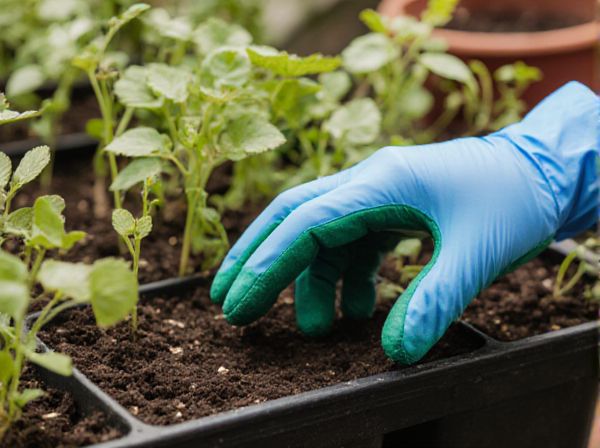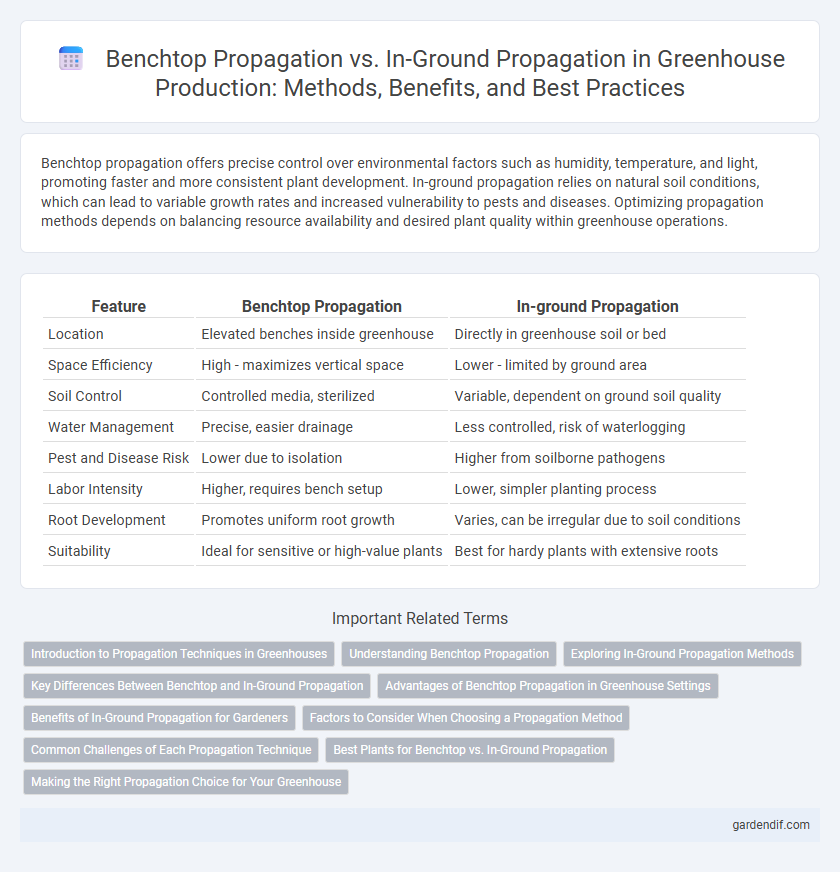
Benchtop propagation vs In-ground propagation Illustration
Benchtop propagation offers precise control over environmental factors such as humidity, temperature, and light, promoting faster and more consistent plant development. In-ground propagation relies on natural soil conditions, which can lead to variable growth rates and increased vulnerability to pests and diseases. Optimizing propagation methods depends on balancing resource availability and desired plant quality within greenhouse operations.
Table of Comparison
| Feature | Benchtop Propagation | In-ground Propagation |
|---|---|---|
| Location | Elevated benches inside greenhouse | Directly in greenhouse soil or bed |
| Space Efficiency | High - maximizes vertical space | Lower - limited by ground area |
| Soil Control | Controlled media, sterilized | Variable, dependent on ground soil quality |
| Water Management | Precise, easier drainage | Less controlled, risk of waterlogging |
| Pest and Disease Risk | Lower due to isolation | Higher from soilborne pathogens |
| Labor Intensity | Higher, requires bench setup | Lower, simpler planting process |
| Root Development | Promotes uniform root growth | Varies, can be irregular due to soil conditions |
| Suitability | Ideal for sensitive or high-value plants | Best for hardy plants with extensive roots |
Introduction to Propagation Techniques in Greenhouses
Benchtop propagation in greenhouses offers controlled environments with consistent temperature, humidity, and light, promoting faster rooting and healthier seedlings compared to in-ground propagation. In-ground propagation relies on natural soil conditions, which may vary and affect the uniformity and success rate of plant growth. Selecting the appropriate propagation method depends on the crop type, space availability, and environmental control capabilities within the greenhouse.
Understanding Benchtop Propagation
Benchtop propagation offers precise environmental control, essential for optimizing temperature, humidity, and light conditions to enhance seedling growth and rooting success rates. This method reduces soil-borne diseases commonly encountered in in-ground propagation by using sterile media and controlled setups. Understanding the benefits of benchtop propagation enables growers to achieve faster, more uniform plant development while conserving space and resources within greenhouse operations.
Exploring In-Ground Propagation Methods
In-ground propagation methods offer a stable thermal environment and consistent moisture levels, enabling robust root development and increased plant vigor in greenhouse settings. Techniques such as layering, root cuttings, and transplanting seedlings directly into prepared beds optimize nutrient uptake and reduce transplant shock. These methods enhance genetic fidelity and pathogen resistance compared to benchtop propagation, supporting sustainable crop production.
Key Differences Between Benchtop and In-Ground Propagation
Benchtop propagation offers superior control over environmental conditions such as temperature, humidity, and light, promoting faster root development compared to in-ground propagation. In-ground propagation relies on natural soil ecosystems, which can introduce variable moisture levels and potential pests, impacting the consistency of plant growth. The portability and ease of monitoring benchtop systems make them ideal for early-stage propagation, while in-ground propagation suits large-scale or long-term plant establishment.
Advantages of Benchtop Propagation in Greenhouse Settings
Benchtop propagation in greenhouse settings offers precise environmental control, leading to higher success rates and faster rooting compared to in-ground propagation. This method reduces soil-borne diseases and pests by using sterile media, which enhances plant health and uniformity. It also optimizes space utilization within greenhouses, allowing for efficient management of propagation cycles and improved resource allocation.
Benefits of In-Ground Propagation for Gardeners
In-ground propagation offers gardeners superior root development and enhanced nutrient absorption due to direct soil contact, leading to healthier and more robust plants. This method leverages natural soil microorganisms that improve plant resilience and growth efficiency, reducing the need for additional fertilizers. Moreover, in-ground propagation supports larger plant sizes and better moisture regulation compared to benchtop propagation, optimizing overall garden yield.
Factors to Consider When Choosing a Propagation Method
Benchtop propagation offers controlled environmental conditions ideal for delicate seedlings, optimizing humidity and temperature for faster root development. In-ground propagation benefits from natural soil fertility and microbial activity, enhancing long-term plant growth and reducing the need for artificial inputs. When choosing a propagation method, consider space availability, climate control requirements, plant species sensitivity, and resource investment to maximize propagation success and crop yield.
Common Challenges of Each Propagation Technique
Benchtop propagation often faces challenges such as inconsistent moisture levels, limited root space, and higher risks of contamination or disease due to close plant proximity. In-ground propagation struggles with soil-borne pathogens, variable soil quality, and difficulty in controlling environmental factors such as temperature and moisture. Both techniques require precise management of humidity, temperature, and sanitation to ensure successful plant development in greenhouse settings.
Best Plants for Benchtop vs. In-Ground Propagation
Benchtop propagation excels with delicate herbs like basil, oregano, and mint due to controlled humidity and temperature, promoting faster rooting and reducing disease risk. In-ground propagation suits hardier plants such as tomatoes, peppers, and squash, which benefit from natural soil nutrients and extensive root expansion. Choosing the right method enhances propagation success by aligning plant species with optimal growing conditions.
Making the Right Propagation Choice for Your Greenhouse
Benchtop propagation offers precise environmental control and quicker root development, ideal for delicate or high-value plants, while in-ground propagation benefits from natural soil conditions, promoting robust growth for hardier species. Choosing the right method depends on factors like space availability, plant type, and desired propagation speed, ensuring optimal greenhouse productivity. Integrating both techniques can maximize efficiency and plant health across diverse greenhouse crops.
Benchtop propagation vs In-ground propagation Infographic

 gardendif.com
gardendif.com